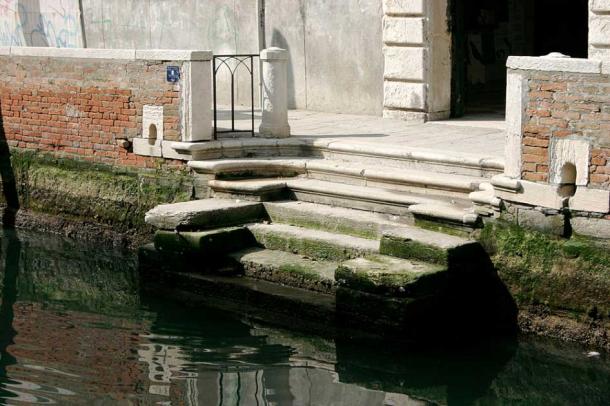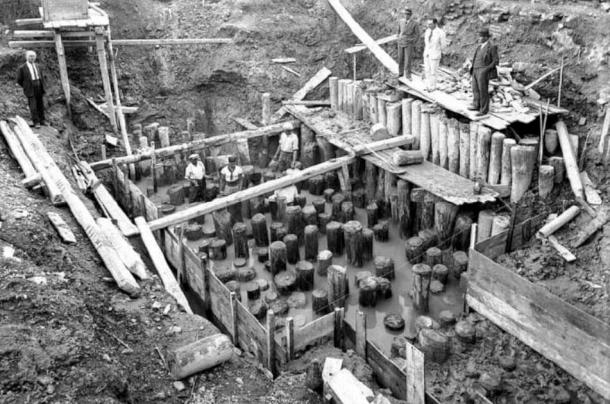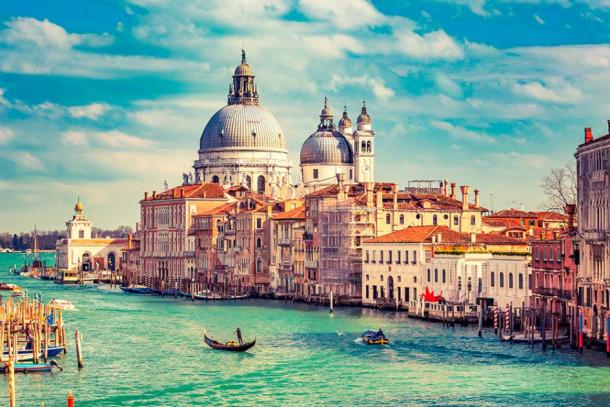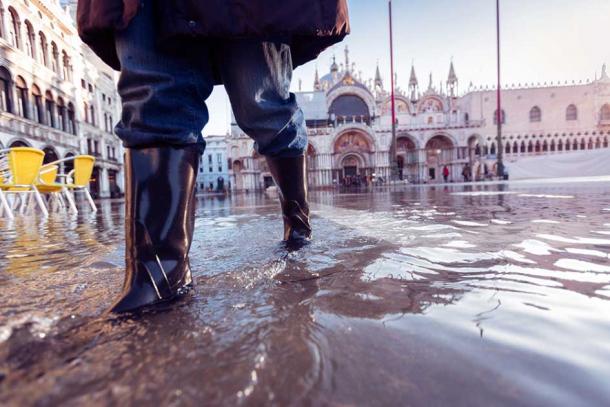
Architecture of the Floating (Or Sinking) City: How Was Venice Built?
The romantic city of Venice is known by many names, including the floating city, the city of canals and even the Queen of the Adriatic. This city of water was built on dozens of tiny islands located in the Venetian Lagoon, a wetland bay of the Adriatic Sea, interconnected by bridges and canals.
If you’re wondering how it was possible to build the stunning architecture of Venice in the midst of what is in essence a swamp, you’re not alone. One of the most frequent questions asked about the Italian city, which was an important maritime power during the Middle Ages and Renaissance, is “how was Venice built?”
- The Republic of Venice, The Greatest Jewel of the Mediterranean?
- Submerged Settlements And Roman Road Discovered Under Venice Waters
While the Venice looks like it is floating on the water, most people assume that the city was built directly on the islands of the Venetian Lagoon. But in fact, the buildings of Venice were built upon wooden platforms supported by wooden stakes driven into the waterlogged ground. This architectural feat is an engineering marvel which has withstood hundreds of years of history.

Low tide provides answers to questions about how Venice was built, exposing the Istrian limestone in its foundations. (Nino Barbieri / CC BY-SA 3.0)
The History and Architecture of the Floating City of Venice
The story of Venice begins in the 5th century AD. After the fall of the Western Roman Empire, barbarians from the north were raiding Rome’s former territories. In order to escape these raids, the Venetian population on the mainland escaped to the nearby marshes and found refuge on the sandy islands of Torcello, Iesolo and Malamocco.
Although the first settlements were temporary in nature, with initial constructions sinking into the mud, the Venetians gradually inhabited the islands on a permanent basis. In order to ensure solid foundations, they developed an ingenious construction method.
This involved driving wooden stakes, measuring between four and eight meters in length (13 to 26 ft), into the mud until they reached the clay bottom of the lagoon floor. On top of these pencil-shaped stakes they assembled wooden platforms, before constructing buildings on top. This created land able to support the heavy structures that continue to exist even today.
Another of the prominent materials used in construction was marble-like Istrian stone, a type of impermeable limestone which was quarried in Istria, Croatia. By some estimates, it made up more than 90 percent of the stone used in the building of Venice.
Istrian limestone is a robust material and was used on top of the wooden platforms as part of the foundations of prominent buildings due to its ability to resist erosion and moisture. While visitors to Venice marvel at the Istrian facades, its use in the foundations has a lot to do with the survival of the ancient city. The limestone was then topped by brick and stone for the visible aspects of the stunning architecture of Venice.

During excavations of ancient buildings in Venice, which have uncovered the use of wooden stakes hammered into the muddy ground, archaeologists have found evidence to help answer the question “how was Venice built.” (Fair Use)
Venice’s Wooden Foundations: How to Build a City in a Swamp
The use of wood as a supporting structure may come as a surprise, since wood is usually less durable than stone or metal. The secret to the longevity of Venice’s wooden foundations is the fact that they are submerged, much like an upside-down underwater forest.
This is because the decay of wood is caused by microorganisms, such as fungi and bacteria. As the wooden support system in Venice is submerged underwater, the stakes are not exposed to oxygen, one of the elements needed by microorganisms to survive. In addition, the constant flow of salt water around and through the wood petrifies the wood over time, turning the wood into a hardened stone-like structure.
Timber was a particularly important commodity for Venetian society, as it was used not just in the foundations of the city, which employed primarily oak and pine, but also for floors, roofs, frames, furniture, and of course ship building at the Venetian Arsenal.
According to one 17th century source detailing the construction methods used in Venice, over a million wooden stakes were used during the building of the Santa Maria Della Salute church, one of the principle architectural features visible on the Venetian skyline. It was a mammoth undertaking.
Each of the wooden stakes used was roughly four meters long (13.1 ft), sourced from the forests of northern Italy, Slovenia, Croatia and Montenegro, and transported to Venice by water. Completed in 1687, Santa Maria Della Salute was erected to give thanks for deliverance from the plague.
Such enormous amounts of timber are thought to have been partly responsible for the deforestation of the Dinaric Karst in the Balkans. There is even a popular saying claiming that Venice “stands on oaks from Karst.” Avoiding this need for large quantities of timber, modern buildings in Venice use reinforced concrete piles instead.

The Grand Canal with the Santa Maria Della Salute church dominating the Venice skyline. (sborisov / Adobe Stock)
Advantages of Venice’s Strategic, and Swampy, Location
While it’s hard to imaging how an insignificant city built on a swamp could become a superpower, its wealthy past is still evident in its illustrious architecture. In point of fact, Venice’s location surrounded by water and on the shores of the Adriatic, were fundamental to its development.
Its geographic position facilitated its development into a key trading hub between the Near East and Europe, and a dominating force over the Eastern Mediterranean, making it a powerful trading center for hundreds of years. Known for its business acumen, it reached its zenith in the 15th century thanks in particular to the role it played in the trade of salt, spices and luxury goods.
As a city surrounded by water, Venice had a distinct advantage over her land-based neighbors. For a start, Venice was secure from enemy invasions. For instance, Pepin, the son of Charlemagne, attempted to invade Venice, but failed as he was unable to reach the islands on which the city was built.
Venice eventually became a great maritime power in the Mediterranean. In one example from 1204, Venice allied itself with the Crusaders and succeeded in capturing the Byzantine capital, Constantinople. Venice, nevertheless, started to decline in the 15th century, and was eventually captured by Napoleon in 1797 when he invaded Italy.

Acqua alta in Venice, the modern-day sinking city. (nullplus / Adobe Stock)
The Threat of Aqua Alta: Venice as the Modern-Day Atlantis?
More than a floating city, these days Venice is more of a sinking city. The lagoon that once protected Venice from countless foreign invaders has become the biggest threat to its survival. Venice is in peril thanks to the rising water levels and the flooding of the city causes chaos several times ever year.
Known as acqua alta (high water), this flooding is generally caused by unusually high tides, which can reach up to three meters (9.8 ft) due to strong winds, storm surges and severe inland rains. However, this is happening more frequently in recent years due to the rising sea level caused by climate change, which is starting to alarm the city.
- 10 Sensational Sunken Kingdoms: Atlantis’ Companions Beneath the Waves
- Finding the Lost City of Heracleion: Encountering Myth Under the Waves
A number of solutions have been proposed to rescue Venice from sinking. One of these measures is the MOSE project, an abbreviation for Modulo Sperimentale Elettromeccanico (Experimental Electromechanical Module). This involves the construction of mobile floodgates designed to separate the lagoon from the Adriatic when the tide exceeds one meter (3.28 ft) above the usual high-water mark. In essence, MOSE creates three gates at the inlets of Lido, Malamocco and Chioggia through which the tide spreads into the Venetian Lagoon and threatens the ancient city.
While the project has been riddled with scandal and has failed to meet its completion deadlines on more than one occasion, many hope that this expensive (running in the billions of euros) and innovative project will be able to safeguard Venice for future generations. Nevertheless, some pessimistic observers doubt that such measures will be sufficient to preserve Venice forever, and that the city will eventually sink, just like the fabled city of Atlantis.
Top image: The buildings of Venice appear to float above the water, begging the question “how was Venice built?” Source: muratart / Adobe Stock
By Wu Mingren
References
Lansing, M. F., 1911. “The Story of Venice” in Mediaeval Builders of the Modern World: Patriots and Tyrants. Gina and Company: Boston. Available at: http://www.gatewaytotheclassics.com/browse/display.php?author=lansing&book=patriots&story=venice
Merali, Z., 19 August 2002. “Saving Venice: An ambitious plan seeks to prevent a modern Atlantis” in Scientific American. Available at: http://www.scientificamerican.com/article/saving-venice/
Och, M., 2004. “Wood” in Fletcher, C. The Science of Saving Venice. Available at: http://venice.umwblogs.org/exhibit/the-conservation-of-venetian-building-materials/wood/
Panwar, R. No date. “Venice: Foundation Details of the Biggest Floating City in the World” in The Constructor. Available at. https://theconstructor.org/case-study/venice-foundation-details/224185/
Schlamp, H.-J. 15 June 2012. “Sinking Feeling: Venice's Eternal Battle against Water” in Spiegel. Available at: http://www.spiegel.de/international/europe/venice-s-struggle-against-the-water-a-838713.html
UNESCO. No date. “Venice and its Lagoon” in UNESCO World Heritage Convention. Available at: http://whc.unesco.org/en/list/394
Wreglesworth, M. No date. “Do The Buildings In Venice Float? How Venice Was Built” in Low Key Architecture. Available at: https://lowkeyarchitecture.com/how-was-venice-built-and-can-the-city-be-saved/
















Comments
There is no edit function here that i could find. I meant to say, the rise was at first very rapid, but since has been slow (small) and consistent.
You are correct that that the flooding has nothing to do with "climate change" (this being the fake-science short hand for Man Caused Global Warming). But it is not a 100 year phenomenon, as you suggest. Sea level has been rising since the end of the last Ice Age. As the massive near-global glaciers melted off and receded from the continents, the sea level rise was very rapid. Over 300 feet in a matter of a century or two. Since then annual sea level rise has been remarkably consistent, though there have been minor periodic fluctuations. So, Venice has been "sinking" since its founding. It is just that in the past 100 years, the rise has reached a height troubling to the city.
The flooding becoming more common has nothing to do with climate change. The city has been slowly sinking over the past century. Slowing since the 1940s.
I like the Idea of this site
I like the Idea of this site